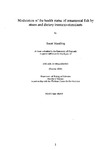Modulation of the health status of ornamental fish by stress and dietary immuno-stimulants
| dc.contributor.author | Maudling, Stuart | |
| dc.contributor.other | Faculty of Science and Engineering | en_US |
| dc.date.accessioned | 2013-11-19T11:51:10Z | |
| dc.date.available | 2013-11-19T11:51:10Z | |
| dc.date.issued | 2006 | |
| dc.identifier | NOT AVAILABLE | en_US |
| dc.identifier.uri | http://hdl.handle.net/10026.1/2761 | |
| dc.description.abstract |
Three trials were conducted to investigate the effects of dietary immuno-stimulant supplementation on various physiological, haematological and immunological parameters of ornamental fish following stress and vaccination. The first series of experiments investigated the mucosal stress response of mirror carp, (Cyprinus carpio), using urinalysis strips and established stress indicators within peripheral blood. A netting stressor, which combined aerial exposure and confinement, of 6 minutes duration was applied and the response of fish was measured 1.5, 3, 5, 24 and 168 hours post-stress. Mucosal haemoglobin and protein were established as consistent indicators of stress and strong relationships could be drawn between them and plasma glucose concentration and peripheral monocytes and lymphocytes counts, firmly establishing them as secondary stress indicators. Visual assessment of the strips was found to overestimate mucosal parameters compared to results obtained using instrument based analysis, but the underlying changes were similar. Further experiments conducted on goldfish, (Carassius auratus), and tilapia, (Oreochromis niloticus x. 0. mossambicus), showed that the mucosal response to stress was conserved between fish species. The second trial investigated the potential of dietary immuno-stimulants to modify the immune status of fish and their response to stress. Fish were fed either a control, beta-glucan (0.2 % w/w), nucleotide (0.2 % w/w) or combined supplement (0.2 % beta-glucan + 0.2% nucleotide) diet for 3 weeks at 1 % BW.dˉ¹ and then to the same stressors as used in Trial 1. Significant stress-induced changes in mucosal protein (p = 0.006), plasma glucose (p = <0.004) and protein concentration (p = <0.003), peripheral lymphocytes (p = 0.001) and monocytes (p = <0.001) and blood NBT reduction (p = <0.001) were observed. Fish fed diets containing immuno-stimulants shower a quicker recovery from the stress-induced hyperglycaemic response than those fed the control diet. Fish that received the beta-glucan diets showed lower blood NBT reduction immediately post-stress than all other diets. The final trial investigated the effects of the control, beta-glucan and combined-supplement diet on the response of fish to vaccination. Fish were fed the diets for 2 weeks prior to and 1 week following IP vaccination against Aeromonas salmonicida at 1.0 % BW.dˉ¹. The immune response was measured every 2 weeks for 12 weeks following vaccination. Vaccination induced a significant stress response as seen by a large hyperglycaemic response (p = <0.05). Significant reductions in peripheral monocyte count were seen following vaccination (p = <0.04). All groups showed elevated NBT reduction at 4 weeks post-vaccination. Serum lysozyme activity showed evidence of long term immuno-suppression following vaccination. No clear effect of the immuno-stimulating diets could be found on any of the physiological or immune parameters tested. The trials conducted found that ornamental fish have a well developed mucosal stress response and this can be used to make inferences about the stress state of fish. The effects of beta-glucans and nucleotides on either the response to stress and immune status were subtle. The nucleotide supplement appeared most effective at reducing the effects of stress, whilst beta-glucans may exert more influence on the immune parameters tested. However, no evidence of synergy between the two types of immuno-stimulant was found in fish fed both immuno-stimulants together. | en_US |
| dc.language.iso | en | en_US |
| dc.publisher | University of Plymouth | en_US |
| dc.title | Modulation of the health status of ornamental fish by stress and dietary immuno-stimulants | en_US |
| dc.type | Thesis | |
| plymouth.version | Full version | en_US |
| dc.identifier.doi | http://dx.doi.org/10.24382/4026 |
Files in this item
This item appears in the following Collection(s)
-
01 Research Theses Main Collection
Research Theses Main


